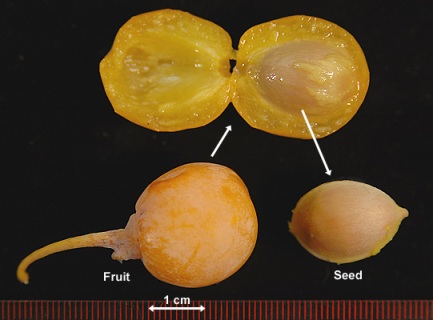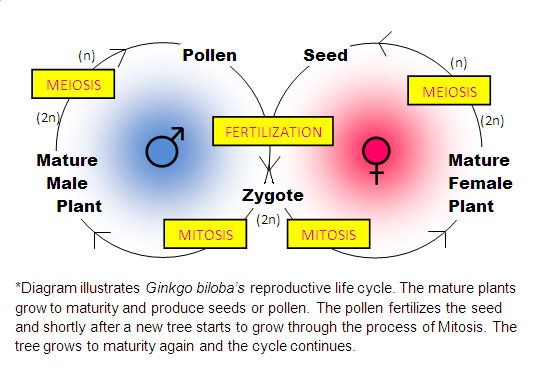Reproduction
Ginkgo biloba is considered to be dioecious, or
(possessing) male and female organs on different trees; because
of this we will take a careful look at both the male and female
plants.
Female Plant
A female Ginkgo biloba produces seeds that are covered by an
outer layer, sometimes referred to as the fruit. Remember, the
phylum to which Ginkgo biloba belongs is the Ginkgophyta.
Ginkgophyta is one of four phylum classified under the
gymnosperms. The word “Gymnosperm” in Greek means “naked seed”
or in other words, these trees are not fruit bearing plants. Besides the fact that the female trees bears
seeds, the adult form of the female Ginkgo tree is
usually pretty easy to tell apart from the male trees because in
the fall, the seeds fall and as they start to decay they produce
butyric acid,
CH3(CH2)2COOH, Butyric acid
causes them stink horribly. Some
people say the "fruit" smells like vomit other say it has more of a
rancid butter type smell; either way, the smell
bearing plants. Besides the fact that the female trees bears
seeds, the adult form of the female Ginkgo tree is
usually pretty easy to tell apart from the male trees because in
the fall, the seeds fall and as they start to decay they produce
butyric acid,
CH3(CH2)2COOH, Butyric acid
causes them stink horribly. Some
people say the "fruit" smells like vomit other say it has more of a
rancid butter type smell; either way, the smell
is not liked by
most.
Other than the smelly outer layer, a female Ginkgo tree is also responsible for making the seeds for fertilization. The seeds are made in pairs and each seed is packed inside a fleshy outer covering. This outer covering appears green in early spring, then changes to yellow, and finally, in fall, it turns a brownish-orange color. Some Anthophytes don’t begin producing their ovaries (fruit) until the seed has been fertilized by pollen, but Ginkgo biloba begins to make their fleshy covering to protect the seed right away. In order for a female Ginkgo biloba plant to start producing seeds, it must reach a mature age of anywhere between 20- 40 years old. This may seem like a really late age to start making seeds, but remember these trees can live up to a thousand years old!

Male Plant
Ginkgophyta and
Cycadophyta (another phylum of Gymnosperms) are the only two phyla of
the Gymnosperms remaining with motile sperm. Because of the flagellated
sperm cells, fertilization can only happen when water is present. Not a
lot of water is needed; a drop or two is sufficient, but the sperm cells
must have a medium to swim through in order to get to the ovule.
A
male Ginkgo biloba plant is much less messy and smelly. The pollen is
produced in little “balls” or cones on the shoots of plants. The wind
then carries the pollen to a female plant where  its goal is to land on a
pollination droplet. This droplet will carry the sperm into the plant.
The sperm can then swim to the ovule (seed) and fertilize it. Now, the
male and female species of the plant usually do not grow and develop
their reproductive organs at the same time. Female Ginkgo trees
typically produce their seeds first, and then about four months later,
the pollen is produced in order to fertilize the female plant.
its goal is to land on a
pollination droplet. This droplet will carry the sperm into the plant.
The sperm can then swim to the ovule (seed) and fertilize it. Now, the
male and female species of the plant usually do not grow and develop
their reproductive organs at the same time. Female Ginkgo trees
typically produce their seeds first, and then about four months later,
the pollen is produced in order to fertilize the female plant.
*The picture above was taken
by Georgia Silvera Seamans,
at localecology.org
Fertilization takes place once the
male and female haploid (n) reproductive cells (seeds and pollen) come
together. Shortly after fertilization occurs the diploid (2n) zygote
begins to grow. After many, many cells divide and grow (through the
process of mitosis) the tree reaches maturity and it produces its own
haploid reproductive cells. This is through the process called meiosis.
As I stated before though, Ginkgo biloba is a dioecious species
meaning that only mature male plants can produce pollen and only mature
female plants can produce seeds. Each tree is either male or female, not
both. The pollen then meets up with the seed again and the cycle
continues. The diagram above helps to illustrate this cycle.
Remember: If you have any trouble at all with the vocabulary I am using,
please check out the GLOSSARY.
Now that you know how the Ginkgo tree reproduces, it’s time to find out
about a few FASINATING FACTS!
HOME

